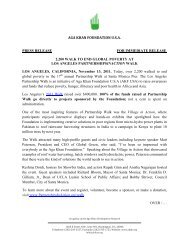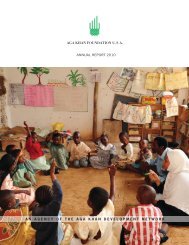2010 Annual Report: Education - PartnershipsInAction
2010 Annual Report: Education - PartnershipsInAction
2010 Annual Report: Education - PartnershipsInAction
Create successful ePaper yourself
Turn your PDF publications into a flip-book with our unique Google optimized e-Paper software.
3. From considering the child as an object to viewing the child<br />
as a subject. The Convention on the Rights of the Child<br />
clearly states the importance of treating children as people<br />
with specific rights. They are people who, even during the<br />
early years, should have the opportunity to offer opinions,<br />
including opinions about how their environment might be<br />
improved, and to be actively involved in their own development<br />
and learning (Lam and Pollard 2006). They should<br />
be listened to. Nevertheless, until recently, most of the research<br />
on transitions was based on information obtained<br />
from adult perceptions of how children adjust to school.<br />
Children were not asked. As a result, some topics of particular<br />
significance to children, such as peer relationships and<br />
bullying, did not necessarily appear as important issues to<br />
be dealt with during the transition.<br />
school, but with levels and kinds of readiness that differ from<br />
child to child and perhaps even group to group. A child may<br />
be healthy and intelligent but is not ready to speak in the national<br />
language. A child may handle the national language<br />
reasonably well but lack certain social skills. Slowly, rather<br />
than think that families and preschools should carry the full<br />
burden for preparing children, more attention is being given to<br />
the idea that primary schools should be more flexible and<br />
should be prepared to change what they do during the early<br />
years in order to be ready for the diverse children they receive.<br />
In writings of the AKF staff and elements of AKF programming,<br />
this way of thinking is reflected. Schools should<br />
be welcoming, inclusive, responsive, offer appropriate and relevant<br />
learning experiences, and know how to work with differences<br />
among the children they receive (Arnold, Bartlett,<br />
Gowani and Shallwani 2008).<br />
Moreover, the Foundation has taken on an important advocacy<br />
role in calling attention to the need to reform and<br />
strengthen the early years of primary school. It has argued<br />
that governments and international organizations tend to give<br />
priority to the later years, failing to provide the resources and<br />
policies necessary to improve the early grades (AKF <strong>2010</strong>).<br />
4. From seeing transition as a moment in time to seeing it as a<br />
continuous process. Much of the transition research and<br />
many of the actions suggested as most pertinent for resolving<br />
transition problems have focused on the moment of<br />
transition to the school or perhaps a brief period before and<br />
another just after making the passage. Children and families<br />
were provided with visits and orientations to the school.<br />
Administrative procedures were introduced to make sure<br />
children’s records from preschool followed them into the primary.<br />
Occasionally, older children were assigned to younger<br />
ones to make sure they had someone to help then navigate<br />
the new environment. The first few days or weeks of school<br />
was sometimes made to feel much more like a continuation<br />
of preschool.<br />
Again, the view has broadened. The passage into school is<br />
now recognized as something that is affected by what happens<br />
long before the actual move occurs and continues well<br />
into the primary school years (Love and Raikes 2007). It is<br />
part of a continuous educational passage in which children<br />
change teachers and curricula and spaces each year in the<br />
school. It is part of a longer-term process of working with<br />
parents and communities.<br />
All of these shifts in thinking and action have involved moves toward<br />
more sophisticated and complicated ways of considering the<br />
passage from home and preschool to school. Keeping this broad<br />
view in mind, let me turn now to discuss what has been done and<br />
what might be done to help children as they shift among learning<br />
environments.






